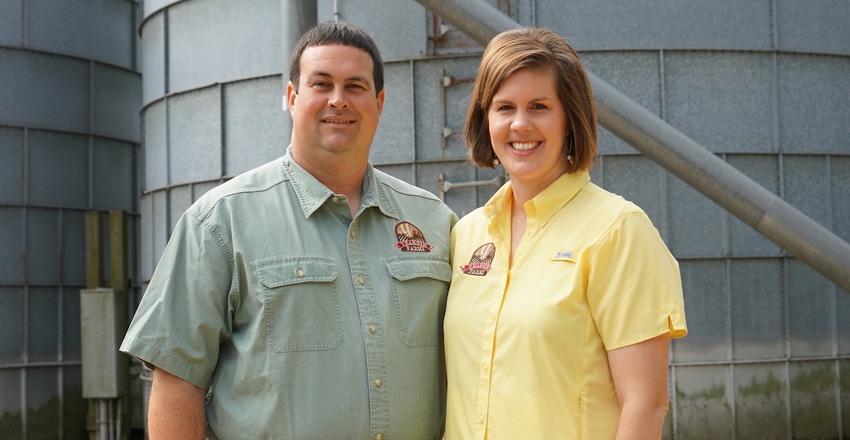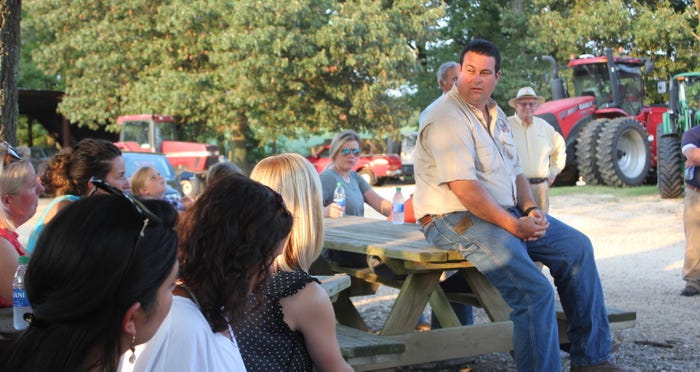
Jay Yeargin always knew he wanted to farm, and he wasted no time getting started. After graduating high school, Yeargin purchased a 60–acre farm in Greenfield, Tenn. with a USDA loan for beginning farmers. He went to work as he also enrolled in college at nearby University of Tennessee at Martin. While many students are still figuring out what they want to do someday, Yeargin was doing it.
Over the years, he bought more farmland and inherited some family land. Now at the age of 39, Yeargin and wife, Alice Ann, farm about 3,500 acres alongside Jay’s parents. They raise soybeans and corn and run a 300-head commercial cow-calf herd. Jay manages most of the day-to-day operations. He also runs custom dozer and mowing businesses.
Jay and Alice Ann were Tennessee’s state winners for the Swisher/Sunbelt Expo Award in 2020 and 2021. (They held the title for two years due to COVID.) We sat down with Jay to talk more about his operation and his outlook for 2022.
Crops
Yeargin Farms uses several different ways to market its crops. They deliver their grain to the best market using their own trucks and have ample grain storage on site. Delivery locations include ethanol facilities, poultry feed mills, and local grain elevators, as well as barge points on the nearby Mississippi River.
“Storage gives us more options and allows us to have our three full-time employees and three part-time employees so we can deliver grain all winter long,” Yeargin said.
Yeargin likes to have 20 percent of the crop sold before planting and then sells in increments of 5 to 10 percent as the crop progresses and production risk declines. Typically, he sells 50% of his crop before harvest begins.
“We use forward contracts, HTAs, basis contracts, options, and cash sales on grain. We also use a broker, Top-Third Marketing, to help us make marketing decisions and increase our grain price,” he said.
In 2004, Yeargin installed a grain dryer, enabling him to begin harvesting his corn crop at 25% moisture and dry down to approximately 17% moisture. He explained, “By doing this we can harvest more bushels in August when prices are 20 cents to 30 cents more and manage the discounts we receive on corn.”
Several years later, Yeargin Farms began the process of growing commercial seed soybeans. This undertaking helped them capture a price premium that would otherwise be a bulk commodity.
“The return from the premium outweighs the extra work of handling seed,” Yeargin said.
They employ no-till and minimum-till on all of their land and plant cover crops to reduce erosion and enhance the soil. They also grow food plots for the local wildlife. Corn is planted and left to attract ducks during their migration season.
“We try to do everything we can to protect the environment given to us. Our young son already shows great interest in the farm, so the best gift we can give him is land that’s been maintained in a sustainable way,” Yeargin said.
Cattle
“As cow calf producers, we market whatever animals are not needed for herd replacement. Calves are weaned and vaccinated before being sold by trailer lot loads to get more from direct buyers and a higher price per pound at between 450 to 650 pounds. We take pride in selling healthy cattle, taking bids on them from buyers, or selling them through organized preconditioned sales using associations such as Tennessee Livestock Producers,” he said.
Yeargin’s calves are born in two separate time windows: October/November and January/February, with the largest portion of the herd calving in the winter months. He has solved the problem of time management during the heavy requirements of calving season by using a fixed breeding season to ensure calves are born when the farm is not planting or harvesting a crop.
He commented, “In the past, calving season was during the early spring, when the cold weather also presented a challenge. For this reason, we use a wooden box we built with heating pads and a heater for temperature control. This way the cows and newborn calves can get the best possible care.”
Risk management
The Yeargins have seen thier share of trials on the farm. In 2012 they faced a terrible drought that lowered yields substantially.
“We had some fields that yielded as low as 4 bushels/acre. Thankfully the cattle side of the farm performed well in 2012 because we were able to source forages for them, and the cash flow helped keep the row crop operation going,” Yeargin said.
He added, “That was a light bulb moment to bolster the critical need for diversification. We also learned to carry a revenue protection policy on enterprise units to insure our crop in the event of another natural disaster. General management issues continue to be the main challenge—knowing when and how to make good decisions in uncertain times and whether to just hold on or to expand.”
2022 looks to be a year that will put farm management practices to a test.
“The next year will be a wild card,” Yeargin said. “We don’t know where crop pices are going to be. We have soaring input costs. It’s going to be a roller coaster ride. Hang on to your seats.”
While it’s hard to lock in a plan with the current volatility in the market, Yeargin said he’s hoping to hold close to the same rotation typically used on the farm.
“It’s still early to make those decisions. We want to see what the market is favoring. But we are going ahead and taking delivery of materials that we know we’re going to use regardless of crop mix because I am concerned about supply chain issues,” he said.
The biggest changes may come to his fertility program, due to high fertilizer prices.
“Everything we farm is grid soil sampled. We usually fertilize according to soil test. This will probably be a year where we don’t figure any kind of build for the soil. We’re just going to replace what is gone,” he said.
“There’s a long time between now and planting, though,” he added. “A lot can change. We’re starting to see some return to normalcy in the supply chain. I think time is in our favor.”

Farm outreach
Despite managing a diversified farming operation, the Yeargins find time to volunteer in their community. Jay and Alice, who grew up on a family farm in eastern Tennessee, serve on numerous agricultural boards and committees. They’re active in church and routinely host farm tours at their operation. Jay is also a lieutenant with the Greenfield, Tenn., fire department.
“We enjoy community outreach,” Jay said. “The community has been good to us, and we want to give back. It’s good to get out of your bubble on the farm and see the world from a different view. It’s also a good way to share the story of agriculture with people who do not farm for a living.”
About the Author(s)
You May Also Like






